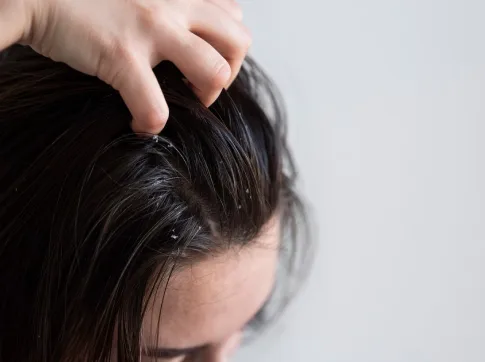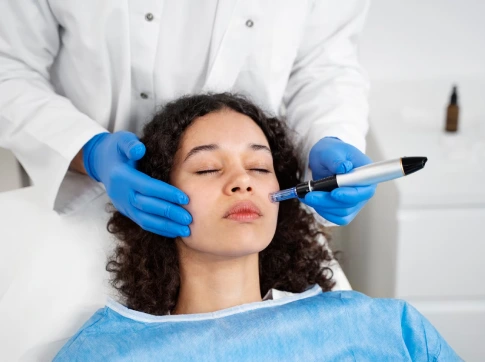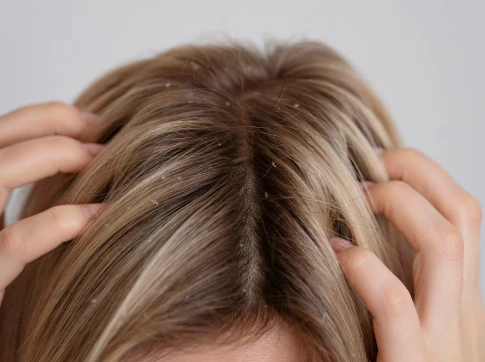Healing Time for Hair Transplant: 20s to 60s & Beyond
27 Oct 2025 Posted By Skinlogics
Hair transplants can transform the appearance and lives of men and women, even transgender individuals. Planning to get a hair transplant? Before going ahead, you might wonder how lengthy hair transplant downtime will be, what post-hair transplant care will need to be followed, and when to expect hair regrowth after a hair transplant in Noida. This blog addresses all doubts and questions regarding the age-wise healing timeline for hair transplants.
One’s Age Makes a Difference in the Healing Phase of Hair Transplant- Learn How
The recovery period is the most crucial phase of the hair transplant journey, which is not the same for any two hair loss victims.
A standard hair transplant is expected to have the following healing phases:
- First Week- Slight redness, swelling, and formation of tiny scabs on both donor and recipient sites
- Second to Third Week- Shedding of scabs and some of the transplanted hair
- One to Three Months- Continued shock hair loss while the operated scalp looks normal
- Three to Six Months- Start of new hair growth
- Six to Twelve Months- New hair thickens and matures
- A Year Beyond- Expected outcomes can be noticed.
However, the recovery timeline after a hair transplant varies for candidates of different age groups. With advancing age, the body’s natural healing abilities and hair cell regeneration retards. Eventually, the quality and speed of scalp healing after a hair transplant are influenced. Let’s further understand this by knowing about the age-related factors that affect hair transplant healing time. The factors are:
- Skin’s firmness and elasticity- This lessens with aging due to loss of skin structural proteins- collagen and elastin, thereby delaying healing
- Hormonal balance- With age, dihydrotesto-sterone (D-HT) and testos-terone levels go out of balance, thus influencing the transplanted hair growth cycles
- Health status- The elderly are more prone to diabetes and hypertension, which slows down scalp healing
- Lifestyle- Poor lifestyle habits like smoking and an unhealthy diet may worsen with advancing age, thereby affecting the healing time.
Timeline for Hair Transplant Recovery by Age Group
Recovery for Hair transplant in 20s
Individuals in their 20s are ideal candidates for hair transplant, as their skin is young and they are most likely overall healthy. Their swift hair cell regeneration, improved collagen support for the skin, and overall good health contribute to a shorter recovery time.
Here’s their expected healing timeline:
- Days 1 to 5- Slight redness and swelling, which quickly resolve.
- Second Week- No crusting; most candidates resume work.
- Months One to Three- Shock hair loss and start of new hair growth
- Months Six to Nine- New hair thickens and matures.
- Months Nine to Twelve or Beyond- Expected outcomes can be noticed.
Recovery for Hair transplant in 30s
Individuals who are in their 30s are also good candidates for a hair transplant. However, their recovery time is likely to be more than the previous age bracket because their bodies are experiencing slight hormonal changes, and them having bad lifestyle habits or a busy routine.
Here’s their expected healing timeline:
- Days 1 to 5- Slight redness and swelling, which quickly resolve.
- Second Week- No crusting; most candidates resume work.
- Months One to Four- Shock hair loss and start of new hair growth by the fourth month.
- Months Six to Nine- New hair thickens and matures.
- Months Nine to Twelve or Beyond- Expected outcomes can be noticed. In some cases, full hair growth takes 12-14 months.
Recovery for Hair transplant in 40s
Individuals who are in their 40s can be candidates for a hair transplant, but their transition phase recovery takes longer. The potential reasons for the delay include slower skin regeneration, more significant hormonal fluctuations, and underlying health issues.
Here’s their expected healing timeline:
- Days 1 to 10- Redness, swelling, and scabs stay.
- Months Three to Five- Start of new hair growth.
- Months Twelve to Fourteen- Expected outcomes can be noticed.
Recovery for Hair transplant in the 50s
Individuals who are in their 50s can be candidates for a hair transplant, but their healing is more gradual and requires more aftercare. The potential reasons for the delay include a decline in the skin’s collagen and elastin, health issues, and medication interactions.
Here’s their expected healing timeline:
- Week Two to Three- Redness and scabs will resolve.
- Months Three to Five- A possible start of new hair growth.
- Months Twelve to Fifteen- Expected outcomes can be noticed.
Recovery for Hair Transplant in 60s and Beyond
Individuals who are in their 60s or older can be candidates for a hair transplant, but their healing is extremely slow and requires proper aftercare. The potential reasons for the delay include thin and fragile scalp skin, more health risks, and the need for extensive aftercare.
Here’s their expected healing timeline:
- By Three Weeks- The initial healing will be over.
- Months Five to Six- A possible start of new hair growth.
- Months Fourteen to Eighteen- Expected outcomes can be noticed.
Is there Age-Specific Hair Transplant Aftercare?
Not really. If you want a swift hair transplant recovery, these are universal hair transplant recovery tips that you must consider:
- Keep body and hair nourished with a healthy diet. Incorporate protein sources, leafy greens, and healthy fats in the diet.
- Ensure adequate hydration. This will ensure proper tissue repair and blood supply in the treated areas.
- Get over bad lifestyle habits. Smoking and alcohol consumption can delay the healing and impact the growth of transplanted hair follicles.
- Take enough rest. Don’t rush to the gym, saunas, steam rooms, swimming pools, or hot baths for a minimum of 2 weeks after a hair transplant. Get proper night sleep and manage stress.
- Adhere to the detailed instructions provided by the hair transplant surgeon. Be consistent with the prescribed medication schedule and surgical wound care. Also, try regular scalp massages or P-RP hair therapy for enhanced, speedy results. Do not miss attending follow-up appointments.
- Patience is the key to good recovery. Stay calm during recovery and wait for the operated areas to naturally heal.
Any adult, irrespective of age, can be a candidate for a hair transplant. However, older candidates will face additional challenges and may experience a delayed recovery. With the right aftercare plan and choice of hair transplant centre and surgeon, it’s easier to reclaim confidence with the final density and volume of hair on the scalp.
If you are ready to start your journey of hair transplant in Noida, get advanced hair transplants from top-notch surgeons and a tailored overall process at Skinlogics Clinic. Take the first step and book your consultation at Skinlogics today.



